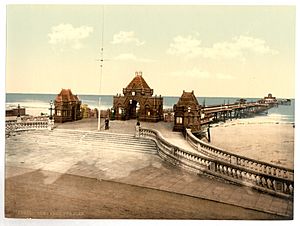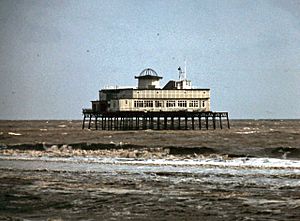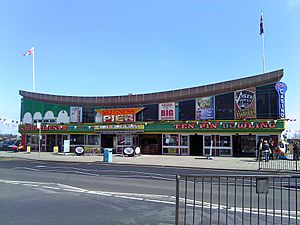Skegness Pier facts for kids
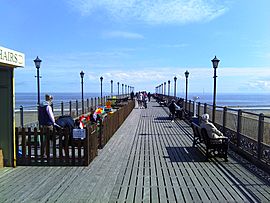 |
|
| Type | Pleasure |
|---|---|
| Carries | Pedestrians |
| Locale | Skegness |
| Maintained by | UK Piers Ltd |
| Design | Clark and Pickwell |
| Owner | Mellors Group LTD |
| Total length | 118 m (387 ft) (562 m (1,844 ft) 1881-1978) |
| Opening date | 4 June 1881 |
| Listed status | Unlisted (previously Grade II) |
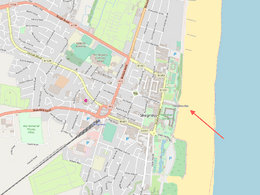
Map showing location of Skegness Pier
|
|
The Skegness Pier is a fun place to visit in Skegness, England. It's a long structure built over the water for people to walk on and enjoy. It first opened in June 1881. Back then, it was one of the longest piers in England, stretching about 562 meters (1,844 feet) into the sea! It even had a T-shape with a concert hall at the very end. For a while, you could even take steamboat trips from the pier to Norfolk.
During World War II, the pier had to close to help protect the country from invasion. Later, in 1978, a very big storm hit and caused a lot of damage. The storm cut off the end of the pier, including the concert hall. These parts were later taken down because it was too expensive to fix them. A fire even broke out during the demolition work!
In recent years, the pier has been updated many times. It now has new decking and is waterproof. This means people can visit it even in winter or when it's raining.
Contents
Where is Skegness Pier?
Skegness Pier is located on Grand Parade Road, which is the B1451. It's about 0.7 miles (1.1 km) from the Skegness railway station. The main building of the pier is home to lots of fun activities. You can find a bowling alley, a laser tag game, and an indoor play area for kids there.
How the Pier Was Built
Planning the Pier
People in Skegness started talking about building a pier around 1877. A group of local business people met to decide if Skegness should have one. Once they agreed, a company called the Skegness Pier Company Limited was set up to manage the project.
They even held a national competition to find the best design for the pier! The winner received £50. Two civil engineers, Clarke and Pickwell, won the competition. Their plan was to build a pier made of cast-iron, about 25 feet (7.6 meters) wide. It would have a large platform at the end with a concert hall that could hold 700 people.
Building and Opening Day
Building the pier was a big job! It was expected to cost around £19,000. The foundations for the pier were started in November 1879. It was designed to be T-shaped with a concert hall at the very end.
The pier officially opened on June 4, 1881, on a day called Whit Monday. The Duke of Edinburgh, Alfred, opened it. The final cost was about £20,840. Skegness Pier was one of the largest of 82 piers built in Britain between 1815 and 1890. During construction, a nobleman named the Earl of Scarborough, Aldred Lumley, became very interested. By the time the pier opened, he owned most of the company. Along the pier, there were shelters every few hundred yards. Small shops on either side sold treats and souvenirs.
Early Fun at the Pier
In the 1890s, over 100,000 people visited Skegness Pier each year! By 1899, a special clock called a Jubilee clock was put up on the promenade. It was paid for by money raised from the public.
A very popular activity starting in 1882 was a steamboat service. Boats would travel from the pier to The Wash and Hunstanton in Norfolk. Because these trips were so popular, local business people even started the Skegness Steamboat Company. However, by the end of 1910, the boat services stopped. Too much sand built up in The Wash, making the journey difficult and unsafe.
In March 1919, a drifting sailing ship called Europa hit the pier. This caused a 150-foot (46-meter) gap in the pier! A temporary platform was put in place to cover the hole until 1939. Then, the pier was fully repaired, which cost £3,272.
Mid-1900s Changes
During World War II, the pier was closed. Parts of its wooden deck were removed to help prevent enemy invasions. The pier didn't reopen until 1948 after repairs were made. By then, it had a cinema, shops, and an amusement arcade. The Pier Saloon at the end of the pier was renovated and became The Pier Theatre. It was very popular with visitors. In 1953, the pier's north-east corner was damaged by a big flood. It cost £3,000 to rebuild.
In the early 1970s, the old entrance archway of the pier was taken down. New shops and amusement arcades were built in 1971. The pierhead theatre was also made bigger, able to seat 1,100 people instead of 700. In 1976, the pier was sold to a local engineering company. The cost of all the updates had made it hard for the original pier company to manage its money.
The Big Storm of 1978
On January 11, 1978, a very strong storm hit the North Sea. This storm caused huge damage to Skegness Pier, as well as other piers. The pier's deck from the main entrance was cut short to only 127 yards (116 meters). The shelters on the eastern side and the pierhead with its theatre were completely cut off from the shore.
After the storm, there was a plan to connect the isolated pierhead with a monorail and build a new theatre. However, this plan failed because they couldn't get enough money. Pieces of the wrecked pier were scattered for miles around. People even came to collect souvenirs.
For several years after the storm, the cut-off parts of the pier remained on Skegness beach. People hoped to repair the pier and reconnect the parts. But because of the very high costs, these plans didn't work out. In 1983, the eastern shelters were taken down.
By 1985, the isolated pierhead was falling apart. It was decided that it needed to be demolished. The upper deck had been badly damaged in the 1978 storm. It had even become a roosting place for starlings! It was also considered a risk to small boats and to the public. Since it was a Grade II listed building, special permission was needed to take it down. Demolition started in October 1985. Then, a fire completely destroyed the building. After the fire burned out, only the cast-iron supports were left, and these were removed in January 1986.
A year later, in October 1987, high storm tides damaged the newer parts of the pier that had been built in the 1980s. The pier's structure underneath had to be secured before the next spring season. By the end of the 1990s, most of these newer parts were removed, revealing the original Victorian pier framework. A bowling center replaced a variety bar in the entertainment center in 1992.
Skegness Pier Today
Today, Skegness Pier is about 118 meters (387 feet) long. There is no sign left of the old pierhead or shelters. A bowling alley was built in 1992. Then, in January 2000, a big renovation project started to bring back its classic charm. Even though it's much shorter now, it's still a very important landmark along the beach.
The pier's deck was updated between 2005 and 2006, costing around £250,000. More improvements were made in 2016-2017 to the enclosed section facing the sea. New covering was added to make it watertight. This allows the pier to open on weekends when lots of people want to visit, even in bad weather.
The pier you see today has parts from different times. The entrance building is from 1970. The central part of the pier deck dates back to 1948. The main deck that stretches along the beach is actually part of the original Victorian pier.
Awards for the Pier
Skegness Pier won a Trip Advisor Certificate of Excellence Award in May 2015. This award celebrates great places in tourism and hospitality. It's based on good reviews from visitors!


